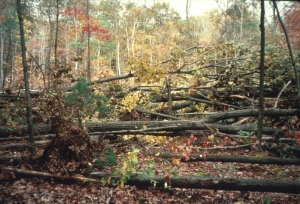
Based on reconstructions and modeling of the history of tropical storms in our region and long-term studies of the impacts of the 1938 hurricane, we have developed a good understanding of many aspects of the role of hurricanes in structuring the forest vegetation in New England. Although only occurring every 50 to 200 years across the landscape, powerful hurricanes create extensive windthrow and forest damage that structures terrestrial and aquatic ecosystems for centuries thereafter. As a consequence, hurricanes are one of the most important natural disturbances affecting the eastern U.S.
Despite our extensive understanding of these storms there are many aspects of their impacts on forest ecosystems that are poorly understood. In particular we have little information on the response of individual tree species to the mechanical damage inflicted by high winds, or the rate and pattern of physiological, population and community response to the changed environment after a storm. Similarly, the rate and types of biogeochemical responses of forests to hurricane damage is very poorly understood.
In order to address these questions and to provide a contrast to other large experiments being conducted at the Harvard Forest, we developed a large hurricane simulation in 1990. By producing an experimental hurricane we were able to collect detailed baseline information on the forest before damage and then follow specific processes and characteristics afterwards. To simulate the hurricane we pulled trees over in a two-acre forested area using a large winch. Data from the 1938 hurricane were used to determine the trees selected for damage and the direction of fall. The resulting pattern provided a realistic simulation of wind damage.
Since 1990 the experimental area and adjoining control site have been studied in detail and have yielded many surprises. In particular the extent and species pattern of survival by uprooted trees was unexpected. In addition the forest ecosystem has proved to be extremely resilient to damage. Very few changes were witnessed in microenvironmental conditions or biogeochemistry despite the massive changes in forest structure.
The experimental hurricane will continue to be studied and compared to long-term data from forests damaged in 1938 and other natural disturbances.
This project is supported by the Harvard Forest Long-Term Ecological Research Program.